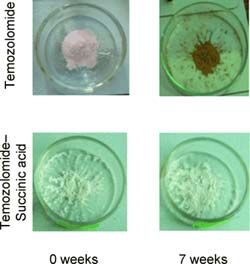Bright White

<br>
Would you want to swallow a tablet that’s yellow rather than its usual white? Would this effect be harmless and would the drug still be efficient?
Researchers in India have now described an approach to maintaining the color and activity of an antitumor agent. As they report in Chemistry – An Asian Journal, acids can protect powders of the drug from discoloration and loss of activity.
The anticancer agent temozolomide is stable in the presence of acid, but when white tablets of the drug are stored for an extended period of time, they turn light pink or tan. This discoloration is indicative of degradation by water in neutral or basic conditions, which lowers the effectiveness of the drug, and has the potential to disconcert patients.
Ashwini Nangia and co-workers at the University of Hyderabad, India, have developed a method to increase the chemical stability of temozolomide and prevent discoloration. They made solids comprising temozolomide that is intimately mixed with an acid, forming so-called cocrystals.
The acid effectively protects the drug from degradation, and the cocrystals showed no signs of discoloration for over six months, even in humid air. As acids, they chose safe organic acids such as acetic acid (found in vinegar), succinic acid (a fermentation byproduct) and oxalic acid (found in rhubarb). Preliminary assessment of the pharmacological properties of the cocrystals indicates that especially those incorporating succinic acid and oxalic acid could be suitable for use in formulation development.
Author: Ashwini Nangia, University of Hyderabad, India, http://202.41.85.161/~an/
Title: Crystal Engineering of Stable Temozolomide Cocrystals
Chemistry – An Asian Journal, Permalink to the article: http://dx.doi.org/10.1002/asia.201200205
Media Contact
All latest news from the category: Life Sciences and Chemistry
Articles and reports from the Life Sciences and chemistry area deal with applied and basic research into modern biology, chemistry and human medicine.
Valuable information can be found on a range of life sciences fields including bacteriology, biochemistry, bionics, bioinformatics, biophysics, biotechnology, genetics, geobotany, human biology, marine biology, microbiology, molecular biology, cellular biology, zoology, bioinorganic chemistry, microchemistry and environmental chemistry.
Newest articles

Trotting robots reveal emergence of animal gait transitions
A four-legged robot trained with machine learning by EPFL researchers has learned to avoid falls by spontaneously switching between walking, trotting, and pronking – a milestone for roboticists as well…

Innovation promises to prevent power pole-top fires
Engineers in Australia have found a new way to make power-pole insulators resistant to fire and electrical sparking, promising to prevent dangerous pole-top fires and reduce blackouts. Pole-top fires pose…

Possible alternative to antibiotics produced by bacteria
Antibacterial substance from staphylococci discovered with new mechanism of action against natural competitors. Many bacteria produce substances to gain an advantage over competitors in their highly competitive natural environment. Researchers…





















